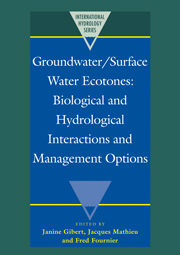Book contents
- Frontmatter
- Contents
- List of authors
- Preface
- I INTRODUCTION
- II FUNCTION OF GROUNDWATER / SURFACE WATER INTERFACES
- III MALFUNCTION OF GROUNDWATER / SURFACE WATER INTERFACES: CAUSES AND METHODS OF EVALUATION
- 19 Heterogeneity of groundwater-surface water ecotones
- 20 Failure of agricultural riparian buffers to protect surface waters from groundwater nitrate contamination
- 21 Stable nitrogen isotope tracing of trophic relations in food webs of river and hyporheic habitats
- 22 La zone hypodermique du sol écotone entre eaux météoriques et eaux souterraines dans l'infiltration des pesticides dissous
- 23 Soils of the north-eastern coast of the Caspian Sea as the zone of sea water/groundwater interaction
- IV MANAGEMENT AND RESTORATION OF GROUNDWATER / SURFACE WATER INTERFACES
- V CONCLUSION
- ANNEX
19 - Heterogeneity of groundwater-surface water ecotones
Published online by Cambridge University Press: 07 September 2010
- Frontmatter
- Contents
- List of authors
- Preface
- I INTRODUCTION
- II FUNCTION OF GROUNDWATER / SURFACE WATER INTERFACES
- III MALFUNCTION OF GROUNDWATER / SURFACE WATER INTERFACES: CAUSES AND METHODS OF EVALUATION
- 19 Heterogeneity of groundwater-surface water ecotones
- 20 Failure of agricultural riparian buffers to protect surface waters from groundwater nitrate contamination
- 21 Stable nitrogen isotope tracing of trophic relations in food webs of river and hyporheic habitats
- 22 La zone hypodermique du sol écotone entre eaux météoriques et eaux souterraines dans l'infiltration des pesticides dissous
- 23 Soils of the north-eastern coast of the Caspian Sea as the zone of sea water/groundwater interaction
- IV MANAGEMENT AND RESTORATION OF GROUNDWATER / SURFACE WATER INTERFACES
- V CONCLUSION
- ANNEX
Summary
ABSTRACT Groundwater-surface water ecotones control hydraulic exchange between groundwater and surface water and, together with land-water ecotones, serve as a temporary or permanent sink of catchment-derived inorganic and organic matter. These factors and the chemistry of water entering an ecotone, determine the ecotone's effect on water quality One of the problems when studying ecotones is their high heterogeneity in space and time. The heterogeneity is caused by several thousand years of human impact, which has been exacerbated during the last century, and by local geology, surface water effects and various ecotonerelated processes (capillary-fringe effect, evapotranspiration, anti-clogging, clogging). The heterogeneity is measurable and at least partly predictable, and should be considered when preparing sampling strategies and evaluating data. Ecotones often function as filters of nutrients and particulate matter, thus improving the quality of water passing through them. The adsorption or buffering capacity of the ecotone, however, may be exhausted which may result in the enrichment of water by organic matter, dissolved metals etc. This ‘malfunctioning’ occurs often naturally as a result of decomposition of accumulated organic matter, but may also be due to the excessive leaching of fertilizers or other substances from upstream areas. Losses from catchments may be diminished by increasing the area and improving the function of the ecotones. The ecotone-oriented measures, however, must be combined with modified land use of the whole catchments if we want to use the landscape in a sustainable way.
- Type
- Chapter
- Information
- Groundwater/Surface Water EcotonesBiological and Hydrological Interactions and Management Options, pp. 151 - 161Publisher: Cambridge University PressPrint publication year: 1997
- 12
- Cited by

